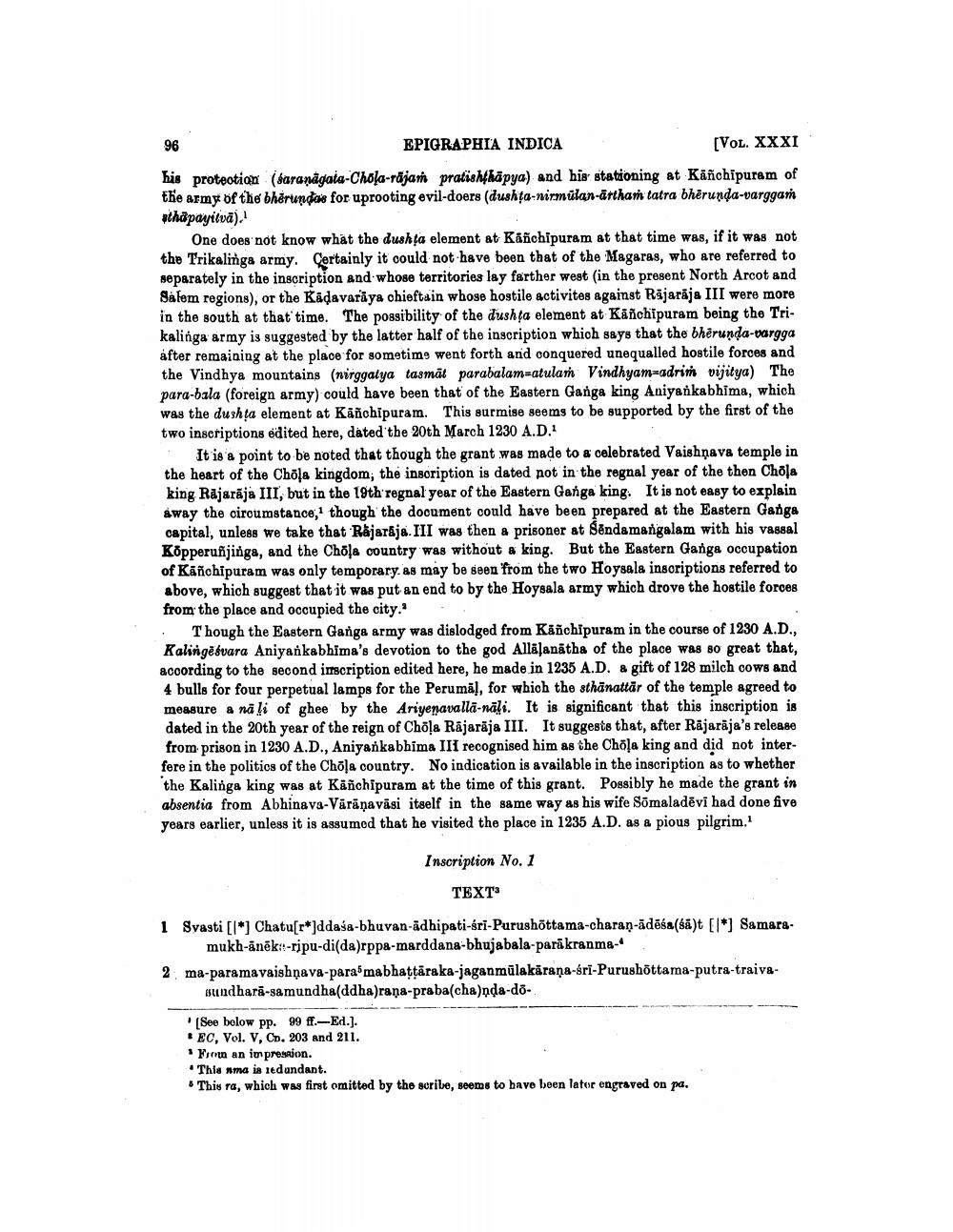________________
96
EPIGRAPHIA INDICA
[VOL. XXXI
his protection (saranagaia-Chola-rajam pratishthäpya) and his stationing at Kanchipuram of the army of the bherundas for uprooting evil-doers (dushța-nirmulan-ärtham tatra bherunda-varggam shpayitva),
One does not know what the dushta element at Kanchipuram at that time was, if it was not the Trikalinga army. Certainly it could not have been that of the Magaras, who are referred to separately in the inscription and whose territories lay farther west (in the present North Arcot and Salem regions), or the Kadavaraya chieftain whose hostile activites against Rajaraja III were more in the south at that time. The possibility of the dushta element at Käñchipuram being the Trikalinga army is suggested by the latter half of the inscription which says that the bherunda-vargga after remaining at the place for sometime went forth and conquered unequalled hostile forces and the Vindhya mountains (nirggatya tasmat parabalam-atulam Vindhyam-adrim vijitya) The para-bala (foreign army) could have been that of the Eastern Ganga king Aniyankabhima, which was the dushta element at Käñchipuram. This surmise seems to be supported by the first of the two inscriptions edited here, dated the 20th March 1230 A.D.1
It is a point to be noted that though the grant was made to a celebrated Vaishnava temple in the heart of the Chōla kingdom, the inscription is dated not in the regnal year of the then Chōla king Rajaraja III, but in the 19th regnal year of the Eastern Ganga king. It is not easy to explain away the circumstance, though the document could have been prepared at the Eastern Ganga capital, unless we take that Rajaraja. III was then a prisoner at Sendamangalam with his vassal Kopperuñjinga, and the Chola country was without a king. But the Eastern Ganga occupation of Kanchipuram was only temporary as may be seen from the two Hoysala inscriptions referred to above, which suggest that it was put an end to by the Hoysala army which drove the hostile forces from the place and occupied the city.
Though the Eastern Ganga army was dislodged from Käñchipuram in the course of 1230 A.D., Kalingesvara Aniyankabhima's devotion to the god Allälanatha of the place was so great that, according to the second inscription edited here, he made in 1235 A.D. a gift of 128 milch cows and 4 bulls for four perpetual lamps for the Perumal, for which the sthänattar of the temple agreed to measure a na li of ghee by the Ariyenavalla-nāli. It is significant that this inscription is dated in the 20th year of the reign of Chōla Rajaraja III. It suggests that, after Rajaraja's release from prison in 1230 A.D., Aniyankabhima III recognised him as the Chōla king and did not interfere in the politics of the Chōla country. No indication is available in the inscription as to whether the Kalinga king was at Kanchipuram at the time of this grant. Possibly he made the grant in absentia from Abhinava-Väränavasi itself in the same way as his wife Sōmaladevi had done five years earlier, unless it is assumed that he visited the place in 1235 A.D. as a pious pilgrim.1
Inscription No. 1 TEXT3
1 Svasti [*] Chatu[r*]ddasa-bhuvan-adhipati-sri-Purushottama-charan-ādēsa (sa)t [*] Samara
2 ma-paramavaishnava-para mabhaṭṭāraka-jaganmülakarana-sri-Purushottama-putra-traiva
mukh-anek-ripu-di(da)rppa-marddana-bhujabala-parakranma
Bundhara-samundha(ddha)rana-praba(cha)nda-do
[See below pp. 99 ff.-Ed.].
EC, Vol. V, Cn. 203 and 211.
From an impression.
This nma is redundant.
This ra, which was first omitted by the scribe, seems to have been later engraved on pa.




